March 12th, 2024
Category: Cloud Computing
No Comments
Posted by: Team TA

1. AI is Poised to Dominate the Cloud Computing Market
Large-scale AI models, like the one used by ChatGPT, require a vast amount of data and processing power, which most companies cannot afford. However, cloud platforms have come to the rescue by providing AI-as-a-service and making this game-changing technology accessible to everyone.
Companies are moving from proof-of-concept to production systems, and by 2024, they will have constructed the necessary infrastructure to facilitate this change. This includes both brand-new AI applications and existing ones that have been enhanced with AI features. It also encompasses a range of platforms, such as edge computing, public clouds, data centers, and mobile devices.
2. Growth of Hybrid Multi-Cloud Solutions
In 2024, a significant trend in cloud computing involves transitioning towards global computing, where businesses move beyond relying solely on public cloud services. Instead, they opt for the most suitable platform for each workload and data type. This evolution, as highlighted by Deloitte, extends the concepts of multi-cloud strategies to new heights.
Predictions indicate a notable increase, from 76% to 85%, in large organizations adopting a multi-cloud approach this year. While this strategy offers cost savings and enhanced flexibility, it also introduces challenges related to data governance and integration with existing legacy systems.
3. Edge Computing Integration
Edge computing involves the storage, processing, and analytics of data that is performed geographically closer to the source. This means that the computation and storage of data are brought nearer to the source sensors and devices. It provides several benefits such as reduced latency, enhanced efficiency, increased privacy, security, and a high rate of data transmission. It works in real time and processes data that is not limited by time. The development of smaller, more power-efficient processors, memory-efficient algorithms, and advanced networks such as 5G will all enhance edge computing’s viability in 2024.
4. Platform Engineering Set to Gain Significant Momentum
More organizations are using cloud technology to support their day-to-day operations. This is because modern digital environments are complex and require robust, scalable, and flexible platforms. Platform engineering involves designing, developing, and managing these systems to ensure they meet the organization’s goals and can adapt to new technology. With the increasing use of cloud-native technologies, platform engineering is becoming increasingly important for the efficient deployment and management of applications.
5. Real-Time Cloud Infrastructure
In 2024, real-time data will become more important than ever before. This means that organizations will prioritize instant access to data storage, such as flash and solid-state storage devices. To meet this demand, cloud infrastructure will be designed for dynamic, immediate access to resources and services through technologies such as serverless computing, edge computing, and flash and solid-state storage.
6. Cloud Security and Resilience
By 2024, three crucial measures will help to mitigate risks and maintain trust in cloud services: data encryption, robust authentication protocols, and comprehensive disaster recovery plans. The frequency and severity of data thefts and breaches are increasing as hackers develop new AI-powered forms of attack. Additionally, any system that requires human access will always be vulnerable to social engineering attacks. Therefore, security and resilience are top priorities for all cloud computing service providers and their customers.
7. Continued Enterprise Data Migration to the Cloud
Cloud computing’s future lies in migrating enterprise data to the cloud, including data from AI initiatives. It demands continuous preparation and optimization for both native-cloud and hybrid-cloud applications. Cloud data management requires better performance, data scalability, storage cost control, availability, and data security standards. The integration of diverse data types is also crucial.
8. Industry cloud platforms
Industry cloud platforms (ICPs) are reshaping the cloud landscape rapidly. Gartner forecasts a remarkable increase in adoption, soaring from less than 15% in 2023 to over 70% by 2027. This surge highlights the immense potential of ICPs in advancing business goals by catering to industry-specific requirements effectively. Gartner further envisions the evolution of ICPs into “ecosystem clouds,” facilitating collaboration among enterprises in various shared processes like procurement, distribution, and payment processing.
9. Underlying Infrastructure for Next-Gen Apps
In 2024, cloud computing is set to become the backbone for creating groundbreaking applications catering to both businesses and consumers. Two important aspects are at play here. First, there’s the expansion of the physical reach of the cloud, known as distributed cloud or edge computing.
As cloud computing spreads out and brings compute power closer to end users, it ensures that user experiences remain smooth with low latency, even as data volumes and computational complexity grow. Second, there’s the availability of advanced technologies within the cloud itself. Whether it’s leveraging AI models and APIs, exploring quantum computing, or embracing upcoming innovations, the cloud provides a convenient pathway for delivering innovation to users.
10. Sustainable Cloud Computing
The major cloud service providers are committed to achieving net-zero carbon emissions. This means they want to balance out the carbon they produce by removing an equal amount from the atmosphere. Amazon plans to reach this goal by 2040, while Microsoft aims to do it even sooner.
Google is also working towards this, with all three companies pledging to use 100% renewable energy for their operations. Whether they succeed is uncertain, but the trend towards greener and more eco-friendly cloud computing will be significant in 2024.
The Bottom Line
Cloud computing in 2024 promises advancements in security, integration, and digital transformation for businesses. From hybrid and edge computing to AI democratization, these ten key trends drive efficiency and innovation. Embracing these trends allows businesses to optimize operations and navigate the evolving technological landscape effectively, ensuring they thrive in the dynamic cloud-powered future.